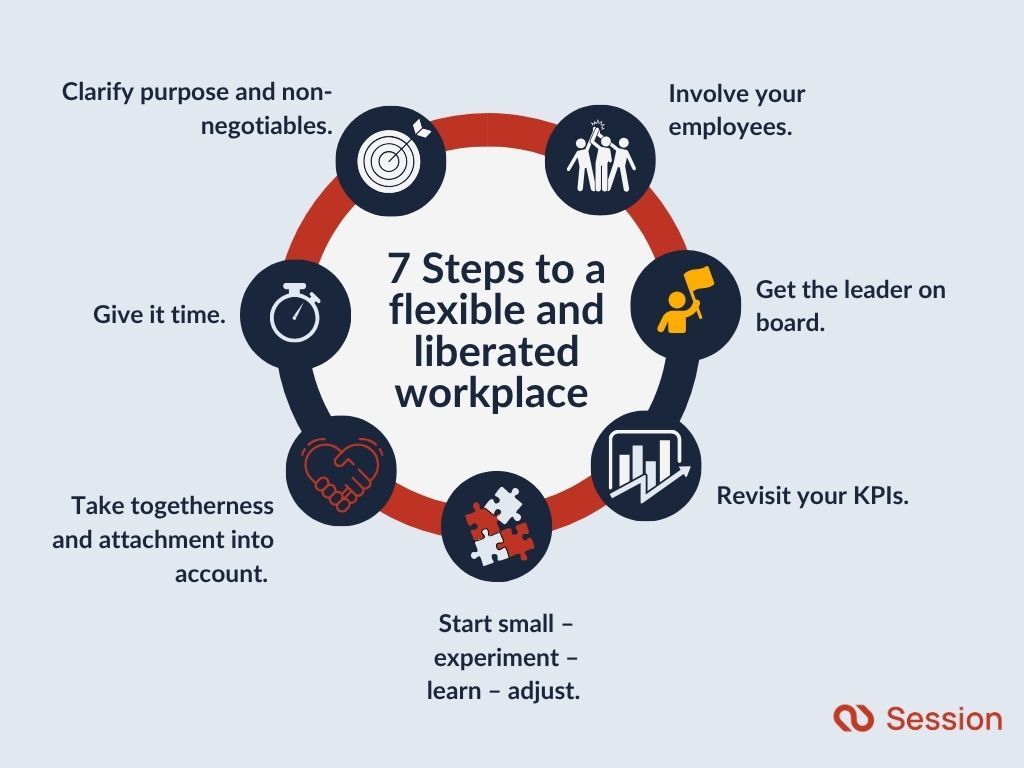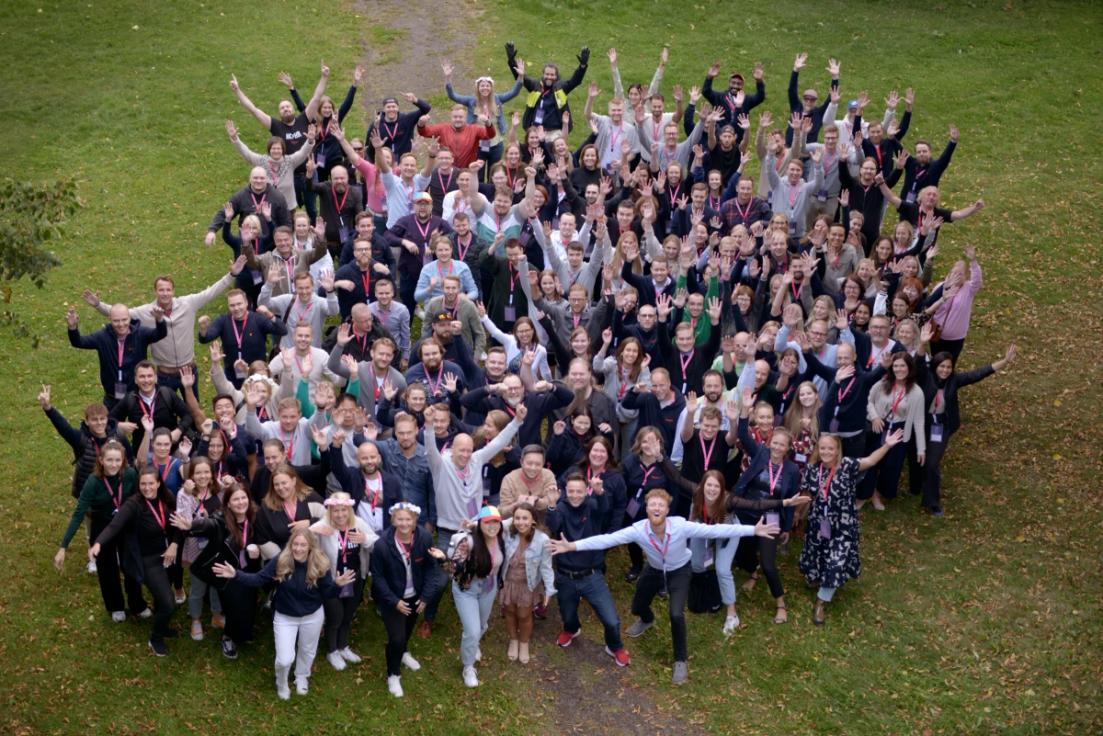Liberated and Flexible.
These are words that usually evoke something positive, desirable, something good. Who wouldn’t want to feel liberated and work in a flexible work environment? And what organization wouldn’t want to offer its employees freedom and flexibility?
But flexibility and freedom come at a price. Those two things do not always lead to happiness, neither for the individual nor for the organization. The themes must be balanced against other things that might be lost in the process, like a sense of belonging and connection. The key challenge, then, is finding a way to combine the best of both worlds: ensuring flexibility without compromising employees’ attachment to the workplace, and offering freedom without weakening the sense of togetherness.
This is the dilemma many HR professionals face today. In this guide, we’ll explore how you can begin building a flexible and liberated workplace, because the question is no longer if we should build them - but how we do it.
Flexibility and Freedom – Why?
Let’s start by taking a closer look at why it’s a good idea for your organization to do what it can to offer employees the benefits of flexibility and freedom.
First and foremost, we’re facing a global labor shortage. Simply put, the competition for talent is intense. Large generations are retiring—or have already done so—and that means there are fewer working-age people to take on the jobs. As a result, companies are being forced to step up their efforts to attract and retain great employees. The flexible workplace has proven to be an effective way to appeal to a broader workforce. Many young employees, in particular, are actively seeking flexibility at work. They have high expectations when it comes to having their individual needs and preferences taken into account, whether that’s regarding working hours, how their work is structured, or how it’s carried out.
In addition, offering flexible working conditions has proven to be a powerful way to boost individual motivation, job satisfaction, and overall well-being, while also enhancing innovation and problem-solving when it comes to getting the job done. Organizations can no longer rely on the default of “doing things the way they’ve always been done.” Instead, they need to rethink processes and procedures so they align not only with each employee’s personal needs (like going to a yoga class at 11 a.m.), but also with the needs of citizens or clients and the business itself. The evidence is clear: when organizations actively work to solve tasks in new and creative ways, the outcomes improve, not just for employees, but also for those who rely on the organization’s services.
How – in practice?
Once you’ve recognized both the growing need to (re-) structure your organization in a way that meets employees’ desire for more flexibility and freedom, and the potential business benefits of doing so—it’s time to take action. But how do you actually get started?

- Clarify purpose and non-negotiables. What’s not up for discussion? What absolutely has to get done? What are the things you simply can’t compromise on? Make this clear to employees, not just in broad terms, but also in relation to their specific roles. Be transparent about where your organization creates value, and why the team, the department, and each individual are essential.
- Involve your employees. Identify a team, a small group, or a department that’s open to trying out a new way of organizing their work. Make it clear that as long as the task gets done, they’re welcome to approach it in a way that suits individual needs. For example, how could you design a shift schedule that meets the company’s need for coverage while also accommodating employees’ desire for flexible working hours?
- Get the leader on board. In organizations with a clear leadership structure, managers need to be closely involved in the process of reorganizing work. It’s not about the manager making all the decisions, but about creating the framework that allows employees to act with autonomy and a sense of freedom.The manager plays a key role in removing barriers that prevent the team from working in new ways. Often, this includes negotiating and communicating with other departments or stakeholders to explain why things are now being done differently—while also showing trust, offering support, and encouraging employees as they take on responsibility in new and more independent ways.
- Revisit your KPIs. Many organizations use KPIs and performance targets that are designed to support a more hierarchical and siloed way of working. But the goal of a liberated organization is to break down those hierarchies and replace them with cross-functional collaboration, experimental and agile work methods, and individual ownership of tasks and customer relationships. If your KPIs don’t reflect this shift, it will be impossible to fully realize the benefits of greater autonomy. Employees naturally move in the direction of what they’re measured on, so make sure you’re measuring the right things!
- Start small – experiment – learn – adjust. Instead of changing everything at once, begin with small experiments. Start with a single department that tries out self-managing their shift schedules, and learn from that experience. Then move on to the next team, carrying those insights with you. Rome wasn’t built in a day - but it was built step by step.
- Give it time. Don’t draw conclusions too early. When you start doing things differently, the organization (or the citizens) may not be ready for it right away. Resistance can arise, people may feel uncertain or hesitant, and some might initially reject the increased flexibility and autonomy, having found comfort in the structure and security of the old system. Acknowledge these reactions, but don’t let them stop you from experimenting; see what unfolds. Hold off on dismissing new approaches until you’ve tested them for at least three months.Change takes time, especially when you’re restructuring towards a freer, more flexible way of working.
- Take togetherness and attachment into account. When you move towards offering more liberated and flexible frameworks for employees, it’s a good idea to also emphasize and insist that this should not come at the cost of the sense of togetherness and attachment to the workplace overall. Not everyone prioritizes work first, so for some, flexibility outweighs everything else. However, as HR, it’s your responsibility to communicate the purpose of the organization and the value of your contributions to employees. Why is your workplace an important part of the bigger picture? What are you contributing to society, and perhaps even to the world? This, along with fostering awareness of colleagues, is what can help ensure that employees gain not only the benefits of freedom and flexibility but also the rewards of inclusion, job satisfaction, and constructive exchanges with their peers.
We hope the above 7 tips for getting started with liberating your organization have inspired you to dive into the experiment of transforming the workplace to something new. As mentioned, it’s no longer a question of if - but when. Good luck on the journey!










